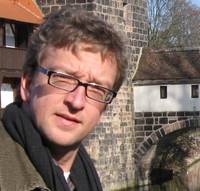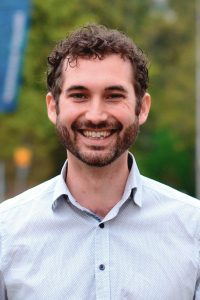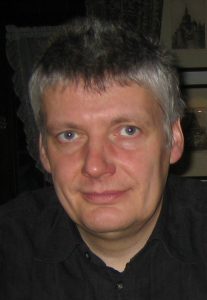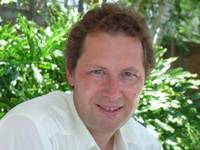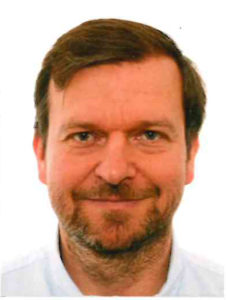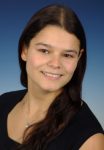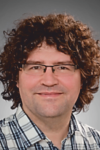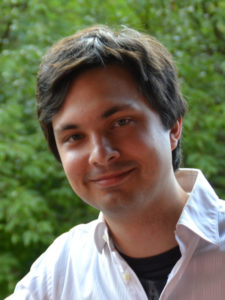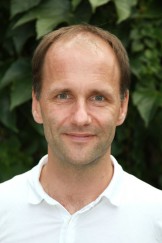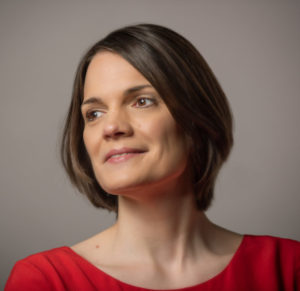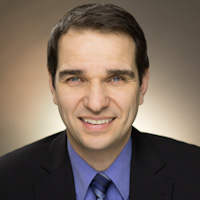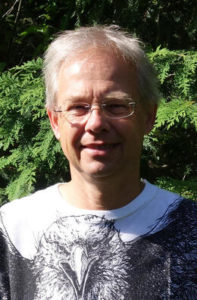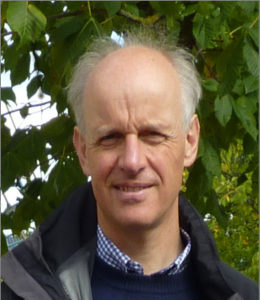Research Projects
Selected Research Projects at the Department of Mathematics
Funding source: DFG-Einzelförderung / Sachbeihilfe (EIN-SBH)
Project leader:
Funding source: Bayerisches Staatsministerium für Wirtschaft, Landesentwicklung und Energie (StMWi) (seit 2018)
Project leader:
Funding source: DFG-Einzelförderung / Sachbeihilfe (EIN-SBH)
Project leader: , ,
Magnetic Drug Targeting unter Einsatz von superparamagnetischen Eisenoxid-Nanopartikeln (SPIONs) ist eine wirksame Methode, um in der Krebstherapie die Wirkstoffapplikation im Tumorgewebe zu steigern, bei gleichzeitiger Reduktion der Gesamtwirkstoffmenge und der mit der Therapie einhergehenden Nebenwirkungen. Während die Wirksamkeit des Ansatzes bereits in Studien nachgewiesen werden konnte, fehlen allerdings bislang Ansätze, um diese Methode an den jeweiligen Behandlungsfall anzupassen und zu o…
Funding source: DFG-Einzelförderung / Sachbeihilfe (EIN-SBH)
Project leader:
Topological invariants and their index theory, the bulk-boundary correspondence and the more recently introduced spectral localizer are well-established mathematical concepts for disordered topological insulators and are also influential for numerical studies of such materials. This proposal is about extending prior results and techniques to systems with crystalline defects, disordered semimetals and topological metals, as well as non-hermitian topological systems stemming from (leaky and driven) photonics and metamaterials. Another part of the proposal aims at a deeper understanding of scattering on such topological systems.
Funding source: EU - 8. Rahmenprogramm - Horizon 2020
Project leader:
The ModConFlex consortium comprises a group of 10 academics and 4 senior researchers in industry (ORE Catapult) with expertise in control theory, artificial intelligence, complex dynamical systems, distributed parameter systems, fluid dynamics, aeroelasticity, power electronics, power systems, swimming theory and marine engineering. Our aim is to train the next generation of researchers on the modelling and control of flexible structures interacting with fluids (water and air), contributing to the latest advances in control theory, artificial intelligence and energy-based modelling. Our main applications are in the control of floating wind turbines (the prime renewable energy source of the future), and in the control of highly flexible aircraft, aircraft with very high aspect ratio. Our research plans are organized into three scientific work packages, which cover mathematical systems theory (modelling and model reduction, boundary control systems, port-Hamiltonian systems, exact beam theory), relevant aspects of control theory (internal model controllers with anti-windup, nonlinear model predictive control, robust control), reinforcement learning, aeroelasticity, stochastic algorithms. We believe that science and technology in Europe will greatly benefit from this research, and from the education and knowledge that we will impart to a new generation of researchers. Key strengths of this consortium include a research environment that brings together mathematicians and engineers to provide the project’s young researchers with a unique training environment, and a network of associated industrial partners that will allow all the young researchers to participate in industrial secondments. We have the critical mass to cover all aspects of training, and we have an excellent track record of past collaboration and of training young researchers.
Funding source: Deutscher Akademischer Austauschdienst (DAAD)
Project leader:
Funding source: DFG / Schwerpunktprogramm (SPP)
Project leader: ,
To couple three interwoven areas of rhizosphere research “Processes, Methods and Applications”, we utilize and improve mechanistic, mathematical models in forms of combined cellular automata and PDE/ODE systems on the microscale, offering the opportunity to bridge scales by homogenization techniques. The
systematic study of the interaction of transformation processes in the rhizosphere focussing on mucilage and root hairs, and its couplings to soil structure, geochemistry, microbiology, and…
Funding source: Deutsche Forschungsgemeinschaft (DFG)
Project leader: ,
Funding source: Elitenetzwerk Bayern
Project leader:
Mountain glaciers and ice caps outside the large ice sheets of Greenland and Antarctica contribute about 41% to the global sea level rise between 1901 to 2018 (IPCC 2021). While the Arctic ice masses are and will remain the main contributors to sea level rise, glacier ice in other mountain regions can be critical for water supply (e.g. irrigation, energy generation, drinking water, but also river transport during dry periods). Furthermore, retreating glaciers also can cause risks and hazards by floods,…
Funding source: Deutsche Forschungsgemeinschaft (DFG)
Project leader:
Our project deals with various operations research problems for optimal decision making during pandemics. We formulate, solve, and analyze our problems with respect to sensitivity and stability. The common feature of our problems is the stochasticity of inputs --- we deal with one or multi-stage stochastic programming problems. Moreover, the probability distribution of the random inputs very often depends on the decisions, hence stochastic problems with endogenous randomness will be of interest. We a…
Funding source: Bayerisches Staatsministerium für Bildung und Kultus, Wissenschaft und Kunst (ab 10/2013)
Project leader:
Funding source: Deutscher Akademischer Austauschdienst (DAAD)
Project leader:
Funding source: Deutscher Akademischer Austauschdienst (DAAD)
Project leader:
Funding source: Deutscher Akademischer Austauschdienst (DAAD)
Project leader:
Funding source: DFG-Einzelförderung / Heisenberg-Programm (EIN-HEI)
Project leader:
Das Ziel des Heisenberg-Programms ist es, herausragenden Wissenschaftlerinnen und Wissenschaftlern, die alle Voraussetzungen für die Berufung auf eine Langzeit-Professur erfüllen, zu ermöglichen, sich auf eine wissenschaftliche Leitungsfunktion vorzubereiten und in dieser Zeit weiterführende Forschungsthemen zu bearbeiten. In der Verfolgung dieses Ziels müssen nicht immer projektförmige Vorgehensweisen gewählt und realisiert werden. Aus diesem Grunde wird bei der Antragstellung und auch später bei der…
Funding source: andere Förderorganisation
Project leader:
Using our expertise in discrete mathematics, in this proposal, we quantify the notion of a fair allocation of medical drugs to users seeking them. We develop mathematical optimization models that ensure all priority groups have an equal access to resources (such as, vaccines) when resources are scarce. Solutions to such mathematical models involve the so-called "water-filling" algorithms - how much demand of multiple users could be satisfied, when the total resource is scarce. In the presence of multiple users - such as when a new priority group is added to a list - the naïve algorithms do not work. The presence of multiple vaccines, such as Pfizer and Moderna, available in different amounts further complicates the logistics. A successful collaboration would ensure: (i) new mathematical models for use by the optimization community, (ii) practical guidelines for distribution of vaccines for the Bavarian and Czech Republic policymakers when new population priority groups are identified, and (iii) support of a masters student working on this project.
Funding source: Alexander von Humboldt-Stiftung
Project leader:
Funding source: Bayerisches Staatsministerium für Wissenschaft und Kunst (StMWK) (seit 2018)
Project leader:
Funding source: andere Förderorganisation
Project leader:
The INR Representation Theory is meant to help mobility of researchers in representation theory between France, UK, Germany, Austria and Japan and to support representation theory (in the broad sense) conferences and workshops involving researchers based in France, UK, Germany, Austria or Japan.
Within this framework, the project "Generations of Representations of Vertex Algebras" is planned in collaboration with Prof. Tomoyuki Arakawa (RIMS, Kyoto, Japan).
Funding source: DFG / Sonderforschungsbereich (SFB)
Project leader: ,
The aim of the project is the systematic investigation of the process-geometry-interaction of thin-walled components for the production of locally adapted properties as well as the modeling of this effect in finite element simulations and structural optimization. In experimental tests, the main influencing factors are identified and mapped in relation to the building position in the process. New exposure technologies and strategies are used to manipulate the melting pool and homogenize component properties. The findings are incorporated into a wall thickness dependent material model for structural optimization, which is investigated in the project. The participating industrial partners will validate the results over the course of the project. The experimental findings and the wall thickness dependent material model will be used to develop a methodology for the product development of thin-walled structures. In the future, the product development process can be accelerated, and the economic efficiency increased. Based on these findings, new application areas for the selective laser beam melting of plastics can be opened up in the future.
Funding source: andere Förderorganisation
Project leader:
As of June 2020, no vaccine is available for the COVID-19 pandemic. The consequently enforced lockdowns
are already crippling the German, Czech, and EU economies; however, they have allowed hospitals to gain
valuable time to increase and/or re-allocate their capacity. Using our expertise in discrete mathematics, in
this proposal, we investigate the idea of a mathematical tradeoff between hospitalization capacity and the
economic GDP losses. Estimating and gathering contagiousness data in different regions for both Germany
and Czech Republic, we seek to prepare a larger joint research proposal . Details are available on request.
Funding source: DFG / Sonderforschungsbereich / Transregio (SFB / TRR)
The subproject ist concerned with stability questions for the non stationary gas flow in gas networks, which is described by the friction dominated ISO-3 model. From the analytical point of view the model consists in a system of nonlinear parabolic partial differential equations which can be transformed into a doubly nonlinear degenerate parabolic equation. We focus on stability issues for the (weak) solution (in the parabolic Sobolev space) with respect to variations of structural parameters and initial-boundary data. In particular, we expect results for the ISO-3 model concerning the stability under variations of friction parameters and the underlying gas model (ideal or real gas).
Funding source: EU - 8. Rahmenprogramm - Horizon 2020, Research infrastructures, including e-infrastructures
Project leader:
We develop mathematical optimization models for distribution of antiviral drugs, under uncertainty, for COVID-19 using both real and estimated data.
Funding source: DFG-Einzelförderung / Sachbeihilfe (EIN-SBH)
Project leader:
The grand goal of this group is the development, analytical, and numerical investigation of a mechanistic model describing processes of formation, stability, and turnover of soil micro-aggregates. In contrast to existing conceptual aggregation models and compartment models for carbon turnover and aggregation, we focus on specific, experimentally identified transformation processes of soil micro-aggregates. Since we are interested in giving an improved mechanistic, qualitative and even quantitative…
Funding source: Bundesministerium für Bildung und Forschung (BMBF)
Project leader:
Funding source: Deutsche Forschungsgemeinschaft (DFG)
Project leader:
In this project we study parabolic partial differential equations (=PDEs) on bounded Lipschitz domains. We aim at justifying the use of adaptive numerical methods when treating such equations. In an adaptive strategy the choice of the underlying degrees of freedom is not a priori fixed but depends on the shape of the unknown solutions. Additional degrees of freedom are only spent in regions where the numerical approximation is still far away from the exact solution. The best one can expect from an…
Funding source: Deutsche Forschungsgemeinschaft (DFG)
Project leader:
The first goal of index theory is to relate topological invariants to indices of Fredholm operators. The most famous result in this direction is the Atiyah-Singer index theorem, but there exist far reaching non-commutative generalizations. While there is a general theory, such index theorems have to be established case by case in applications. The second goal of index theory is to connect invariants and indices of problems related via exact sequences. For example, this allows to read off the topology…
Funding source: DFG / Sonderforschungsbereich (SFB)
Project leader: ,
Funding source: DFG / Sonderforschungsbereich (SFB)
Project leader:
The objective is the development of a mathematical framework which allows to conclude from desired optical properties to a corresponding optimised configuration of single particles as well as particle assemblies. A structural optimisation approach based on discrete dipole approximations is explored to allow for a design space with sufficiently high resolution and enabling the prediction of structure-property relations of individual particles. For particle assemblies a structural optimisation method…
Funding source: Industrie
Project leader:
Funding source: DFG / Sonderforschungsbereich / Transregio (SFB / TRR)
Project leader:
In diesem Projekt sollen Datenassimilationstechniken für Modelle von Strömungen in Gasnetzen entwickelt werden. Dabei werden Messwerte in laufende Simulationen eingespeist, um ihre Genauigkeit und Zuverlässigkeit zu erhöhen. Dazu werden die originalen Modellgleichungen um Steuerungsterme in den Röhren oder an den Knoten erweitert, die die Lösung in Richtung der Messdaten verschieben. Das so entstehende System wird als Beobachter bezeichnet. Hier soll untersucht werden, wie viele Messdaten nötig sind, …
Funding source: DFG-Einzelförderung / Sachbeihilfe (EIN-SBH)
Project leader: ,
Funding source: DFG-Einzelförderung / Sachbeihilfe (EIN-SBH)
Project leader:
Funding source: DFG / Graduiertenkolleg (GRK)
Project leader: ,
We extend the rigorous identification of Griffith models from atomistic systems governed by Lennard-Jones interactions [FrSc15a] to general lattice systems including long-range and multi-body interactions. Here, we will apply techniques from the paper [BaBrCi20] and complement their analysis by showing the Cauchy-Born rule in the setting of small displacements. Applying the Gamma-convergence approach to composite materials, we also aim at studying the influence of different mesoscopic on the macroscopic…
Funding source: DFG / Schwerpunktprogramm (SPP)
Project leader: ,
The self-organization of the aggregates in the rhizosphere by various
attracting forces influenced by geochemistry, and microbiology shall
be studied by a novel, comprehensive model. This model should
account for processes on the microscale (single roots, pore scale),
and then be upscaled to the root system scale (macroscale) by
mathematical homogenization. This goal exceeds the functional range
of existing models for aggregation and needs the introduction of an
explicit…
Funding source: DFG / Graduiertenkolleg (GRK)
Project leader: ,
In previous works, the dependence of failure mechanisms in composite materials like debonding of the matrix-fibre interface or fibre breakage have been discussed. The underlying model was based on specific cohesive zone elements, whose macroscopic properties could be derived from DFT. It has been shown that the dissipated energy could be increased by appropriate choices of cohesive parameters of the interface as well as aspects of the fibre. However due to the numerical complexity of applied simulation methods the crack path had to be fixed a priori. Only recently models allow computing the full crack properties at macroscopic scale in a quasi-static scenario by the solution of a single nonlinear variational inequality for a given set of material parameters and thus model based optimization of the fracture properties can be approached.
The goal of the project is to develop an optimization method, in the framework of which crack properties (e.g. the crack path) can be optimized in a mathematically rigorous way. Thereby material properties of matrix, fibre and interfaces should serve as optimization variables.
Funding source: DFG / Graduiertenkolleg (GRK)
Project leader: ,
In a continuum the tendency of pre-existing cracks to propagate through the ambient material is assessed based on the established concept of configurational forces. In practise crack propagation is however prominently affected by the presence and properties of either surfaces and/or interfaces in the material. Here materials exposed to various surface treatments are mentioned, whereby effects of surface tension and crack extension can compete. Likewise, surface tension in inclusion-matrix interfaces can often not be neglected. In a continuum setting the energetics of surfaces/interfaces is captured by separate thermodynamic potentials. Surface potentials in general result in noticeable additions to configurational mechanics. This is particularly true in the realm of fracture mechanics, however its comprehensive theoretical/computational analysis is still lacking.
The project aims in a systematic account of the pertinent surface/interface thermodynamics within the framework of geometrically nonlinear configurational fracture mechanics. The focus is especially on a finite element treatment, i.e. the Material Force Method [6]. The computational consideration of thermodynamic potentials, such as the free energy, that are distributed within surfaces/interfaces is at the same time scientifically challenging and technologically relevant when cracks and their kinetics are studied.
Funding source: Deutscher Akademischer Austauschdienst (DAAD)
Project leader:
Funding source: EU - 8. Rahmenprogramm - Horizon 2020
Project leader:
Funding source: DFG-Einzelförderung / Sachbeihilfe (EIN-SBH)
Project leader:
Funding source: Deutscher Akademischer Austauschdienst (DAAD)
Project leader:
The project is located in pure mathematics and deals with a problem in geometric representation theory. Parity sheaves and moment graph techniques have proven to be extremely effective in answering questions in modular representation theory. In the finite-dimensional case a hypercohomology functor establishes a connection between parity sheaves and sheaves on moment graphs. However the geometry controlling representation theoretic phenomena in this case is often infinite-dimensional. We plan to…
Funding source: Bayerisches Staatsministerium für Bildung und Kultus, Wissenschaft und Kunst (ab 10/2013)
Project leader: ,
Ziel des Projekts ist es, AVX2 Vektoroperationen für die Common LispImplementierung SBCL verfügbar zu machen. SBCL ist derpopulärste und am weitesten Entwickelte freie Compiler für CommonLisp. Die Verbesserungen aus diesem Projekt machen es möglichCommon Lisp Programme zu schreiben, deren Ausführungsgeschwindigkeitmit C++ und Fortran Programmen auf Augenhöhe liegt. Dadurchergeben sich interessante Möglichkeiten der Metaprogrammierung imwissenschaftlichen Rechnen.
Funding source: DFG / Sonderforschungsbereich / Transregio (SFB / TRR)
Project leader: ,
The goal of this research project is to study uncertain optimization problems using robust optimization methods. Focusing on transport networks, we aim at the development of tractable robust counterparts for uncertain optimization problems and an analysis of the problem structure. For the arising adjustable robust optimization tasks, good relaxations as well as effective branch-and-bound implementations shall be developed.
Funding source: DFG / Sonderforschungsbereich / Transregio (SFB / TRR)
Project leader: ,
The main goal of this project is the development of mathematical methods for the solution of multilevel, mixed-integer, and nonlinear optimization models for gas markets. To this end, the focus is on a genuine four-level model of the entry-exit system that can be reformulated as a Bilevel model. The mathematical and algorithmic insights shall then be used to characterize market solutions in the entry-exit system and to compare them to system optima. Particular attention is paid to booking prices…
Funding source: DFG / Sonderforschungsbereich / Transregio (SFB / TRR)
Project leader: ,
In this subproject we will develop techniques to solve equilibrium problems with integer constraints using MIP techniques. To this end, we will consider first mixed-integer linear, then mixed-integer nonlinear problems as subproblems. To solve the resulting problems we will study both complete descriptions as also generalized KKT theorems for mixed-integer nonlinear optimization problems.
Funding source: DFG / Sonderforschungsbereich / Transregio (SFB / TRR)
Project leader: , ,
The focus lies on the development of mathematical decomposition methods for mixed-integer nonlinear optimal control problems on networks. On the top level (master) mixed-integer linear problems are in place, whereas in the sub-problem only continuous variables are considered. The exchange between the levels is performed not only via cutting planes, but also via the modelling of disjunctions to deal with non-convex optimal control problems as well. The overall emphasis is the mathematical analysis…
Funding source: DFG-Einzelförderung / Sachbeihilfe (EIN-SBH)
Project leader: ,
The theoretical limits of distributed compressive sensing are studied bytools from both information theory and statistical physics. The investigationscover both noise-free and noisy distributed compressive sensing. The theoretical insightsare utilized to design approximate message passing algorithms for joint recovery of large distributed compressive sensing networks with feasible computational complexity. These algo-rithms enable us to verify the non-rigorous results obtained by the replica method…
Funding source: DFG / Sonderforschungsbereich / Transregio (SFB / TRR)
Project leader:
Turnpike results provide connections between the solutions of transient and the corresponding stationary optimal control problems that are often used as models in the control of gas transport networks. In this way turnpike results give a theoretical foundation for the approximation of transient optimal controls by the solutions of stationary optimal control problems that have a simpler structure. Turnpike studies can also be considered as investigations of the structure of the transient optimal controls.…
Funding source: DFG / Graduiertenkolleg (GRK)
Project leader:
Funding source: Deutsche Forschungsgemeinschaft (DFG), DFG-Einzelförderung / Sachbeihilfe (EIN-SBH)
Project leader:
The porous-medium equation and the thin-film equation are prominent examples of nonnegativity preserving degenerate parabolic equations which give rise to free boundary problems with the free boundary at time t > 0 defined as the boundary of the solution’s support at that time.
As they are supposed to describe the spreading of gas in a porous-medium or the spreading of a viscous droplet on a horizontal surface, respectively, mathematical results on the propagation of free boundaries become r…
Funding source: Bundesministerium für Bildung und Forschung (BMBF)
Project leader: ,
Funding source: Bundesministerium für Bildung und Forschung (BMBF)
Project leader:

